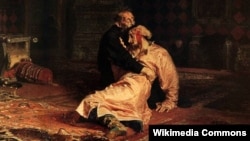If great art is supposed to be provocative, then there can be no doubt about the greatness of Ilya Repin's 1885 canvas "Ivan the Terrible and his Son, Ivan, on November 16, 1581."
When it was first unveiled, it so offended the Russian imperial government that it was banned from being shown -- probably the first (but, sadly, not the last) painting to endure such censorship in Russia.
In 1913, a Russian Old Believer named Abram Balashov attacked the painting with a knife, stabbing it three times while shouting "Enough blood! Down with blood!" Balashov was ushered away to a psychiatric hospital.
The badly damaged painting was painstakingly restored and returned to Moscow's Tretyakov Gallery, where it hangs today among thousands of other works of art that comprise much of Russia's incredibly rich cultural legacy.
But not for long if a group of Russian nationalists has its way. Vasily Boiko-Veliky, chairman of the Holy Rus organization, and a group of conservative historians have signed an appeal to Russian Culture Minister Vladimir Medinsky and Tretyakov Director Irina Lebedeva asking that Repin's masterpiece be consigned to the vaults for "offending the patriotic feelings of Russian people who love and value their ancestors and who are grateful to them for creating a great, powerful state -- the Russian Orthodox Monarchy."
Repin's psychologically intense painting shows Tsar Ivan the Terrible in a fit of horror after striking his son and heir, Ivan, with his scepter during an argument. Ivan the son died a few days later and, when Ivan the Terrible himself died in 1584, the crown passed to his feeble and childless son Fyodor.
When Fyodor died in 1598, it marked the end of the Rurikid dynasty and the beginning of a catastrophic 15 years that has gone down in Russian history as the Time of Troubles. The Russian state nearly collapsed during this period under the combined pressure of a devastating famine, widespread civil strife, and foreign invasion. About one-third of the population died before the Romanov dynasty was established in 1613.
In Repin's portrait, Ivan the Terrible seems to be having a horrific presentiment of the disaster that his impetuous and uncontrolled rage has brought on his family and his country.
But Boiko-Veliky and his group of Orthodox, nationalist co-signers argue there is no historical evidence that Ivan the Terrible actually killed his son and that the "myth" that he did was invented and disseminated by "foreign ambassadors" who likely poisoned the heir in preparation for their war to destroy Russia.
In an interview with the Russian News Service, Boiko-Veliky noted that Culture Minister Medinsky cast doubt on the notion that Ivan the Terrible killed his son in his book, "Black Myths About Russia."
In an interview with Kommersant-FM radio, art historian Andrei Yerofeyev said: "This isn't the first attempt to settle scores with Russian art -- either contemporary or historical -- with Pushkin, with Tolstoy, with Dostoevsky, and now with Repin. That is people try to solve their internal problems, their problems in their relations with their fellow countrymen, and with their country by fighting against their own culture. They want to replace it, proclaim it Russophobic. We have developed this type of obscurantism -- and not just at the margins of society. They have also appeared in universities and have entered into various advisory bodies, into the Culture Ministry, and they are quietly moving up the ladder."
Yerofeyev added that it is "absolutely" possible that Medinsky might agree with the complaint against the painting. He noted that last year prosecutors in St. Petersburg investigated an exhibition at the State Hermitage Museum after nationalist Cossacks complained it was "blasphemous" and "hurt their religious sensibilities."
The wave of nationalist-Orthodox cultural revisionism has been growing in Russia ever since Vladimir Putin came to power in 2000. Earlier this year, "The Calvert Journal" published a feature on Ilya Glazunov's Russian Academy of Painting, Sculpture, and Architecture. Glazunov urges artists to "be worthy of yourselves and shoulder the great task of being an artist who expresses the national self-consciousness of his people."
"At a time when contemporary artists are increasingly coming into conflict with the state, particularly in response to recent impositions on freedom of expression exemplified by events such as the Pussy Riot affair and the introduction of new laws against so-called 'homosexual propaganda,'" the article concludes, "it is important to remember that the Russian right wing continues to train its own legions of artists" that are obsessed with a "dangerous reverence for a nonexistent past."
Even if the government does not respond to the request to remove Repin's painting, Boiko-Veliky's letter could be still be dangerous. The complaint also states that Repin himself was punished by God for his deeds -- "his right hand withered and he could neither paint nor cross himself." The letter continues that "after the revolution in 1917, while he was in exile in Finland, he radically changed his views, began to attend Orthodox services, and sang in the choir."
It continues in what can only be seen as a thinly veiled appeal to some unbalanced figure like the unfortunate Abram Balashov. Because of his late-life change of heart, the letter says, "today [Repin] would clearly be grateful to anyone who destroyed this slanderous painting."
The Tretyakov Gallery announced on October 3 that the painting will be placed under special security.
-- Robert Coalson
Russia's Dangerous Struggle With Obscurantism

Related
About This Blog
Written by RFE/RL editors and correspondents, Transmission serves up news, comment, and the odd silly dictator story. While our primary concern is with foreign policy, Transmission is also a place for the ideas -- some serious, some irreverent -- that bubble up from our bureaus. The name recognizes RFE/RL's role as a surrogate broadcaster to places without free media.







